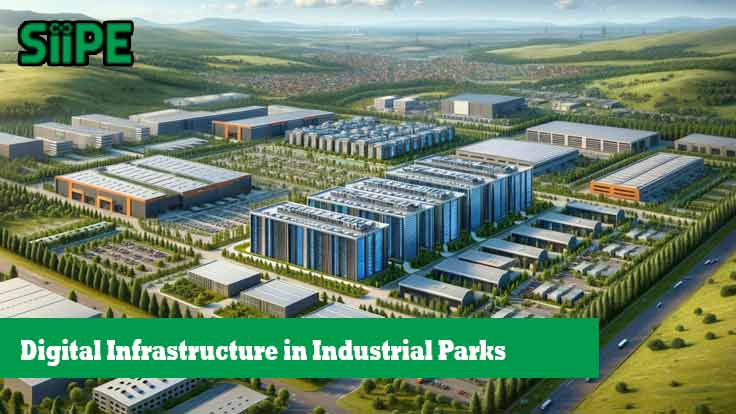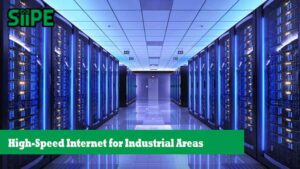In the era of Industry 4.0, digital infrastructure is no longer a luxury — it is a necessity. For industrial parks aiming to remain competitive, efficient, and sustainable, investing in robust digital infrastructure is key to unlocking long-term success.
From smart sensors to 5G connectivity, cloud platforms to data centers, digital infrastructure serves as the backbone of smart industrial ecosystems. It enhances productivity, supports automation, improves decision-making, and attracts high-value tenants. This article explores the role, components, benefits, and implementation strategies of digital infrastructure in modern industrial parks.
What is Digital Infrastructure?
Digital infrastructure refers to the foundational technologies, systems, and services that enable the operation, management, and innovation of digital processes. In the context of industrial parks, it encompasses:
-
High-speed internet and 5G connectivity
-
IoT (Internet of Things) sensors and devices
-
Cloud computing platforms
-
Cybersecurity systems
-
Data centers and edge computing
-
Digital twin and simulation tools
-
Smart utility grids and energy management systems
Why Digital Infrastructure Matters in Industrial Parks
Industrial parks today are not just clusters of factories—they are hubs of integrated, intelligent activity. Here’s why digital infrastructure is crucial:
1. Enables Smart Manufacturing
Automation, robotics, and real-time monitoring rely on fast and reliable connectivity. With digital infrastructure, factories can operate more efficiently with less downtime.
2. Improves Resource Efficiency
Smart grids, water management systems, and energy monitoring platforms help optimize consumption and reduce waste.
3. Attracts High-Tech Tenants
Companies involved in electronics, biotech, logistics, and AI prefer to operate in areas with robust digital infrastructure.
4. Supports Sustainability Goals
Data-driven operations allow better environmental tracking and compliance with ESG standards.
5. Enhances Operational Resilience
Cloud-based platforms and remote monitoring allow continuous operation, even during disruptions like pandemics or natural disasters.
Key Components of Digital Infrastructure in Industrial Parks
Let’s explore the core building blocks of a digitally advanced industrial zone:
🔌 1. High-Speed Connectivity & 5G Networks
Fiber optics and 5G technology ensure seamless data flow between devices, systems, and control rooms. They enable:
-
Real-time machine monitoring
-
AR/VR applications in training and maintenance
-
Autonomous guided vehicles (AGVs) and drones
☁️ 2. Cloud Computing & Edge Infrastructure
Industrial parks require scalable computing power for:
-
Data storage
-
Predictive analytics
-
Enterprise resource planning (ERP) systems
-
AI and machine learning integration
Edge computing, located closer to devices, reduces latency and enhances response time.
📊 3. IoT and Smart Sensors
IoT devices collect real-time data across production lines, warehouses, and utilities. They support:
-
Predictive maintenance
-
Asset tracking
-
Environmental monitoring (air quality, temperature, etc.)
🔐 4. Cybersecurity Systems
With more devices connected, industrial parks are vulnerable to cyber threats. Essential defenses include:
-
Firewalls and intrusion detection
-
Secure access control
-
Regular audits and compliance protocols
🧠 5. Digital Twin Technology
A digital twin is a virtual replica of physical assets. It allows operators to simulate scenarios, optimize performance, and reduce maintenance costs.
🏭 6. Integrated Smart Utilities
Digital systems for power, water, and waste enable:
-
Load balancing
-
Real-time leak detection
-
Carbon footprint monitoring
Benefits of Digital Infrastructure for Stakeholders
| Stakeholder | Key Benefits |
|---|---|
| Manufacturers | Faster production, predictive maintenance, higher quality |
| Park Operators | Efficient facility management, lower OPEX, smart billing |
| Investors | Higher ROI, ESG compliance, future-proof assets |
| Government | Increased GDP, digital innovation, global competitiveness |
Case Studies: Digital Infrastructure in Action
🇸🇬 Jurong Innovation District (Singapore)
One of Asia’s leading smart industrial estates, Jurong integrates 5G, AI, and autonomous vehicles. It serves as a testbed for digital manufacturing solutions and is home to research centers and high-tech firms.
🇩🇪 Siemensstadt Square (Germany)
This digitally connected urban-industrial hub features energy-efficient buildings, automated logistics, and IoT-driven infrastructure. A perfect example of digital and green integration.
🇮🇩 Batang Industrial Park (Indonesia)
The government plans to equip this strategic industrial zone with 5G-ready networks and cloud-based management systems to attract global manufacturers.
Challenges in Developing Digital Infrastructure
Despite its clear benefits, the adoption of digital infrastructure comes with barriers:
-
High upfront investment costs
-
Lack of digital skills among tenants and operators
-
Cybersecurity risks
-
Fragmented legacy systems
-
Limited access to funding for SMEs
Strategies for Successful Implementation
To ensure the success of digital transformation in industrial parks, stakeholders can adopt the following strategies:
✅ 1. Develop a Digital Master Plan
Outline a long-term roadmap that aligns technology implementation with the park’s vision and business model.
✅ 2. Public-Private Partnerships (PPP)
Collaborate with telecom companies, cloud providers, and government agencies to fund and deploy technology at scale.
✅ 3. Start with Pilot Projects
Begin with manageable, high-impact projects like smart lighting or water monitoring, then scale up based on results.
✅ 4. Build Digital Literacy
Offer training and upskilling programs for tenant employees to adopt and manage new technologies.
✅ 5. Standardize and Interconnect Systems
Avoid vendor lock-in by choosing open, interoperable platforms and promoting integration across facilities.
Future Outlook: Smart, Green, and Connected
As digital and sustainability agendas converge, the future of industrial parks lies in being smart, green, and connected. Here are some trends shaping tomorrow’s industrial ecosystems:
-
Integration of AI and big data for supply chain optimization
-
Blockchain for secure, transparent industrial transactions
-
Digital carbon accounting tools for ESG compliance
-
Metaverse-like interfaces for remote monitoring and collaboration
Industrial parks that embrace digital infrastructure today will be tomorrow’s leaders in innovation, efficiency, and sustainability.
The integration of digital infrastructure into industrial parks is no longer optional—it’s a competitive necessity. It enables smarter manufacturing, efficient resource use, and increased investor appeal.
Governments, developers, and operators must work hand in hand to ensure that industrial parks evolve into resilient, future-ready ecosystems, equipped to meet the demands of a dynamic, digital economy.











